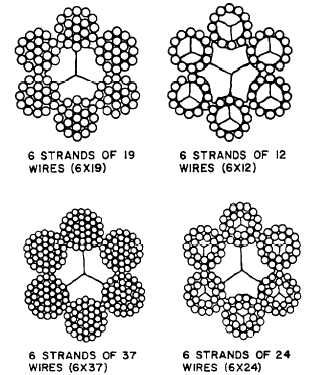| |
Figure 3-25.–Arrangement of strands in wire rope.
As shown in figure 3-26, wire rope is laid up in
various ways:
RIGHT REGULAR LAY: Wires in the strands are
twisted to the left; strands in the rope are twisted to the
right.
LEFT REGULAR LAY: Wires in the strands are
twisted to the right; strands are twisted to the left.
Figure 3-26.–Lays of wire rope.
RIGHT LANG LAY: Both wires in the strands and
strands in the rope are twisted to the right.
LEFT LANG LAY: Both wires in the strands and
strands in the rope are twisted to the left.
USES OF WIRE ROPE
Chapter 613 of the Naval Ships' Technical Manual
specifies the uses that may be made of wire rope of
various constructions. A few of the more common
constructions and some of their uses follow:
6 X 7: Only the galvanized type is specified. It is not
suitable for general hoisting, but is applicable for
permanent standing rigging.
6 X 19: Size for size, this type of construction is the
strongest of all the wire ropes. When made of
galvanized wire, 6 X 19 is used principally for heavy
hoisting and is particularly useful on derricks and
dredges. Standing rigging, guys, boat slings, and
topping lifts for booms are often made of galvanized
6 X 19 wire rope. Phosphor bronze 6 X 19 rope is used
for lifelines, wheel ropes, radio antennas, antenna
downleads, and so forth, where either noncorrosive or
nonmagnetic properties are desirable.
6 X 37: When made of ungalvanized steel wire, this
construction is flexible, making it suitable for cranes
and similar machinery. It may be used for heavy
hoisting. For instance, hoisting ropes larger than 1 3/4
inches in diameter usually are of this type. When made
of galvanized steel wire, this wire rope may be used for
steering gear, boat crane falls, towing hawsers, bridles,
torpedo slings, and heavy running rigging.
CARE OF WIRE ROPE
Long lengths of wire rope are usually on reels
when received from your supply activity. Never try to
unreel wire rope from a stationary reel. Mount the
reel on a pipe or rod supported by two uprights. This
method allows the reel to turn as the wire rope is
pulled. Unreeling presents no problem, but spooling
the wire rope back onto the reel may give you some
trouble unless you remember that it tends to roll in the
opposite direction from the lay. For example, a
right-laid wire rope tends to roll to the left.
Consequently, start a right-laid wire rope at the left
and work toward the right when spooling over the top
of the reel. When spooling under the reel, start at the
right and work toward the left. Naturally, handle
left-laid wire rope just the opposite.
3-19
|





